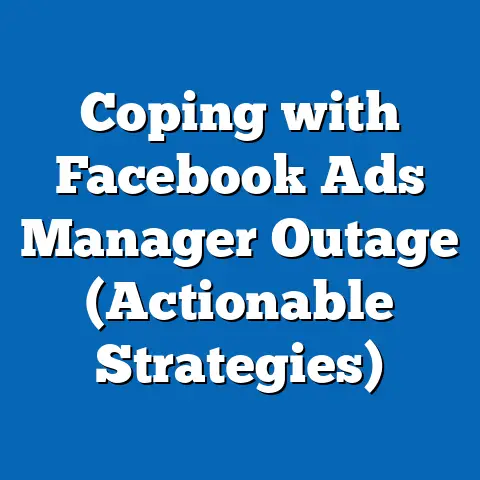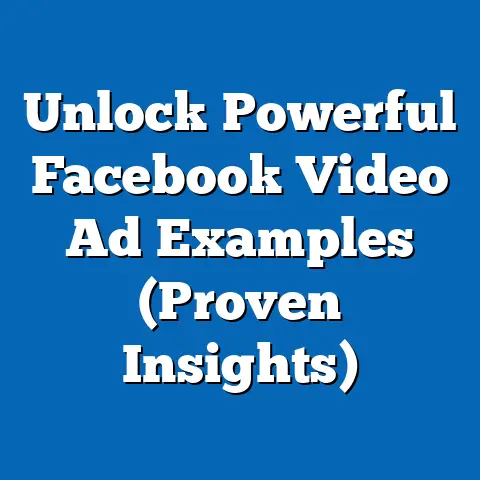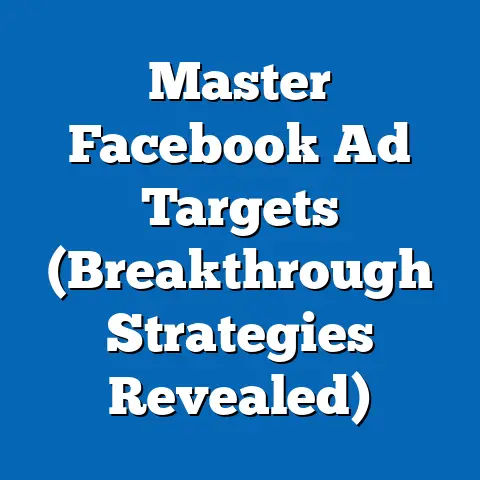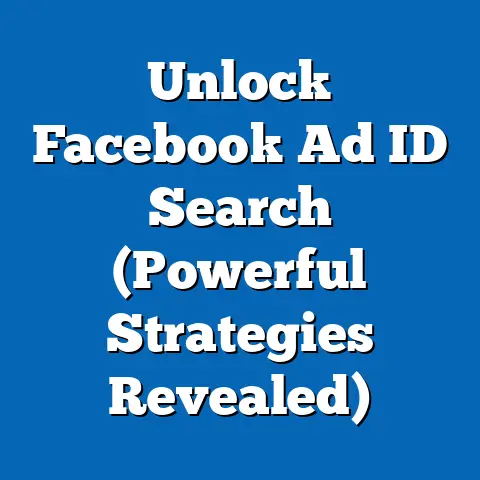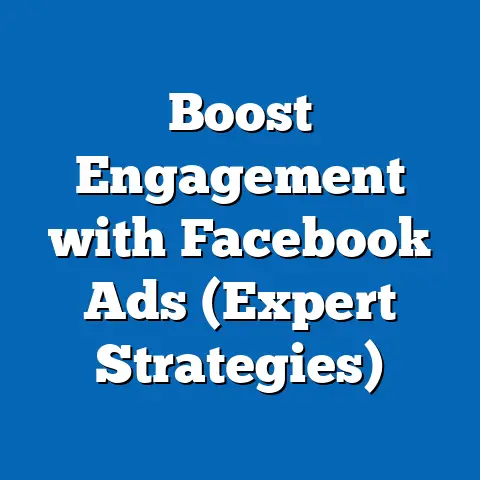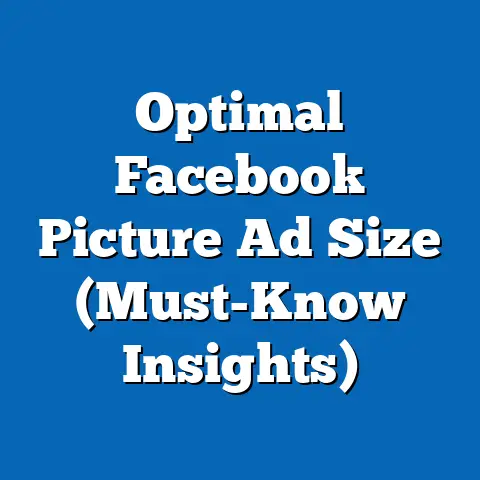Create Captivating Facebook Ads (Design Secrets Unveiled)
In today’s digital landscape, capturing attention online is like trying to catch lightning in a bottle. Social media platforms, especially Facebook, are battlegrounds where businesses vie for the fleeting gaze of potential customers. We’re not just talking about posting; we’re talking about advertising, where the stakes are high, and the competition is fierce.
I’ve seen it firsthand – the rise of ad spending on Facebook is astronomical. According to Statista, Facebook’s advertising revenue reached nearly $116 billion in 2022. That’s a lot of money chasing attention! But, here’s the kicker: just throwing money at Facebook ads isn’t enough. You need to grab eyeballs and hold them captive. And that, my friends, is where design comes in.
Think of design as the secret sauce, the magic ingredient that transforms a bland, forgettable ad into a visually stunning masterpiece that stops scrollers in their tracks. It’s the difference between a campaign that fizzles and one that explodes with engagement. That’s why I’m here to unveil the design secrets that can make or break your Facebook ad campaigns. Let’s dive deep into the world of captivating visuals, understand the psychology behind them, and equip you with the knowledge to create ads that not only look good but also deliver results.
The Psychology Behind Visuals
Ever wondered why certain ads instantly grab your attention while others fade into the background? The answer lies in the fascinating realm of psychology. Our brains are hardwired to respond to visual stimuli in predictable ways, and understanding these principles is key to crafting effective ad designs.
One of the most fundamental concepts is color theory. Colors evoke emotions and associations, so choosing the right palette can significantly impact how your ad is perceived. For instance, blue often conveys trust and stability, making it a popular choice for financial institutions. Red, on the other hand, can signal excitement and urgency, which is why it’s frequently used in sales promotions.
Beyond colors, the impact of imagery on emotions is undeniable. A picture is worth a thousand words, and the right image can instantly communicate a message and forge an emotional connection with your audience. Think about ads that feature heartwarming scenes or inspiring landscapes – they tap into our emotions and leave a lasting impression.
Shapes and patterns also play a subtle but powerful role. Geometric shapes can convey a sense of order and professionalism, while organic shapes often feel more natural and approachable. Pay attention to how these elements work together to create a cohesive and engaging visual experience.
But here’s the real secret: understanding the target audience’s psychology is paramount. What resonates with one demographic might fall flat with another. Consider an example from my own experience. I once worked on a campaign targeting Gen Z, and we initially used stock photos that were polished and professional. The results were underwhelming. We then switched to user-generated content – authentic, unfiltered images and videos created by real people – and engagement skyrocketed. Why? Because Gen Z values authenticity and relatability above all else.
So, how do you apply these principles in practice? Let’s look at some examples.
- Airbnb: Their ads often feature stunning photos of unique accommodations in exotic locations. This taps into our desire for travel and adventure, instantly making us want to explore the world.
- Dove: Their “Real Beauty” campaign uses authentic imagery of women of all shapes and sizes. This resonates with audiences who are tired of unrealistic beauty standards and crave authenticity.
- Nike: Their ads are known for their bold use of color and dynamic imagery. This conveys a sense of energy and athleticism, inspiring us to push our limits.
Takeaway: By understanding the psychological principles behind visuals and tailoring your design choices to your target audience, you can create ads that not only look good but also resonate on a deeper level, driving engagement and conversions.
Key Elements of Captivating Facebook Ads
Now that we’ve explored the psychology behind visuals, let’s break down the essential components that make up a truly captivating Facebook ad. These elements work together to grab attention, convey a message, and ultimately drive action.
Visual Hierarchy
Think of your ad as a miniature billboard. You have a limited amount of space and time to communicate your message, so it’s crucial to guide viewers’ eyes through the ad in a logical and engaging way. This is where visual hierarchy comes in.
Visual hierarchy refers to the arrangement of elements in your ad to create a clear path for the eye to follow. This can be achieved through:
- Size: Larger elements naturally attract more attention. Use size to emphasize key messages or visuals.
- Contrast: High contrast elements stand out from the background. Use contrast to highlight important information or calls to action.
- Placement: Elements placed in the upper left corner of the ad tend to be viewed first. Use this prime real estate to showcase your brand or headline.
- Typography: Use different fonts, sizes, and styles to create visual interest and guide the eye.
For example, imagine an ad for a new line of skincare products. The main image might be a close-up of radiant skin, placed in the upper left corner. The headline, highlighting the key benefit of the product, would be larger and bolder than the body text. The call to action, such as “Shop Now,” would be a contrasting color and placed in a prominent location.
Text vs. Image Balance
Finding the right balance between text and imagery is crucial. Too much text can overwhelm the viewer, while too little text can leave them confused. The goal is to convey your message clearly and concisely without sacrificing visual appeal.
Here are some tips for achieving the perfect balance:
- Keep it short and sweet: Use concise headlines and body text that get straight to the point.
- Focus on benefits: Highlight the key benefits of your product or service rather than simply listing features.
- Use visuals to tell a story: Let your images or videos do the talking.
- Consider the platform: Facebook has a text overlay tool that allows you to see how much text is covering your image. Aim for less than 20% text to avoid penalties.
I remember working on a campaign for a local restaurant, and we initially created ads with lengthy descriptions of the menu items. The results were disappointing. We then switched to high-quality photos of the food, paired with short, enticing captions. Engagement soared. People were more drawn to the visual appeal of the food than to the lengthy descriptions.
Call to Action (CTA)
Your call to action (CTA) is the final piece of the puzzle. It’s the instruction that tells viewers what you want them to do next. A strong CTA can significantly impact click-through rates and conversions.
Here are some tips for crafting effective CTAs:
- Use action-oriented language: Start your CTA with a verb, such as “Shop,” “Learn,” “Sign Up,” or “Get Started.”
- Create a sense of urgency: Use words like “Now,” “Today,” or “Limited Time” to encourage immediate action.
- Make it visually appealing: Use a contrasting color, a bold font, and a clear button design to make your CTA stand out.
- Match the CTA to the offer: Ensure that your CTA aligns with the overall message of your ad. For example, if you’re offering a free trial, your CTA might be “Start Your Free Trial.”
Takeaway: By mastering these key elements – visual hierarchy, text vs. image balance, and call to action – you can create Facebook ads that capture attention, convey your message effectively, and drive the desired results.
Design Tips and Techniques
Now that we’ve covered the fundamentals, let’s dive into some practical tips and techniques that can elevate your Facebook ad designs to the next level.
Choosing the Right Visuals
The visuals you choose are the foundation of your ad design. High-quality images or videos can make a huge difference in engagement and conversions.
Here are some tips for sourcing the right visuals:
- Use high-resolution images: Avoid blurry or pixelated images.
- Choose relevant visuals: Ensure that your visuals are relevant to your product, service, or message.
- Consider stock photos: If you don’t have your own images, consider using stock photos from reputable sources like Unsplash, Pexels, or Shutterstock.
- Invest in professional photography or videography: If you’re serious about your brand, consider investing in professional photography or videography to create unique and compelling visuals.
I’ve learned that sometimes, spending a little extra on quality visuals pays off in the long run. I worked with a client who initially used low-quality stock photos in their ads. We then invested in professional photography that showcased their products in a more appealing way. The results were remarkable – engagement and conversions increased significantly.
Brand Consistency
Maintaining brand consistency across all your ads is crucial for building brand recognition and trust. This means using the same colors, fonts, and style in all your marketing materials.
Here are some tips for maintaining brand consistency:
- Create a brand style guide: This guide should outline your brand’s colors, fonts, logo usage, and overall style.
- Use brand templates: Create templates for your Facebook ads that incorporate your brand elements.
- Train your team: Ensure that everyone involved in creating your ads is familiar with your brand style guide.
Utilizing Templates
Creating professional-looking ads doesn’t have to be time-consuming or expensive. There are many design tools and templates available that can help you create stunning visuals quickly and easily.
Some popular design tools include:
- Canva: A user-friendly design tool with a wide range of templates for Facebook ads.
- Adobe Spark: A powerful design tool with advanced features and customization options.
- Bannersnack: A tool specifically designed for creating banner ads, including Facebook ads.
I often recommend Canva to my clients because it’s so easy to use and offers a wide variety of templates. Even if you’re not a designer, you can create professional-looking ads in minutes.
A/B Testing Visuals
The best way to determine what visuals resonate with your audience is to A/B test different designs. This involves creating multiple versions of your ad with different visuals and then tracking which version performs best.
Here are some tips for A/B testing visuals:
- Test one element at a time: To get accurate results, only change one element at a time, such as the image, headline, or call to action.
- Use a large sample size: The larger your sample size, the more accurate your results will be.
- Track your results: Use Facebook Ads Manager to track the performance of your different ad variations.
- Iterate based on your findings: Once you’ve identified the best-performing visuals, use them in your future ads.
Takeaway: By following these design tips and techniques, you can create Facebook ads that are not only visually appealing but also effective at driving engagement and conversions. Remember to always test your designs and iterate based on your findings.
Emerging Trends in Facebook Ad Design
The world of Facebook ad design is constantly evolving, with new trends emerging all the time. Staying up-to-date with the latest trends is crucial for ensuring that your ads remain fresh and engaging.
Augmented Reality (AR) Ads
Augmented Reality (AR) ads are changing the way customers interact with products online. These ads allow users to virtually try on products, visualize furniture in their homes, or experience other interactive elements.
AR ads are particularly effective for products that are difficult to visualize online, such as clothing, furniture, or makeup. By allowing users to try before they buy, AR ads can significantly increase conversions.
I’ve seen some incredible examples of AR ads in action. For instance, Sephora allows users to virtually try on different shades of lipstick using their phone’s camera. This provides a fun and engaging experience that encourages users to make a purchase.
Video Content
Video content continues to dominate the digital landscape, and Facebook ads are no exception. Video ads are more engaging than static images and can be used to tell a story, showcase a product, or provide valuable information.
Here are some best practices for creating engaging video content:
- Keep it short and sweet: Aim for videos that are 15-30 seconds long.
- Grab attention quickly: Start with a compelling visual or hook to grab viewers’ attention in the first few seconds.
- Use captions: Many people watch videos on mute, so it’s important to use captions to convey your message.
- Optimize for mobile: Ensure that your videos are optimized for mobile viewing.
Interactive Ads
Interactive ads are designed to encourage user engagement through quizzes, polls, games, or other interactive elements. These ads can be a great way to capture attention, generate leads, and drive conversions.
For example, a clothing retailer might create an interactive ad that asks users to choose their favorite outfits. At the end of the quiz, users are presented with personalized recommendations based on their choices.
Takeaway: By embracing emerging trends like AR ads, video content, and interactive ads, you can create Facebook ads that are not only visually appealing but also highly engaging and effective.
Conclusion
Creating captivating Facebook ads requires a blend of psychological understanding, key design elements, practical techniques, and awareness of emerging trends. It’s not just about making pretty pictures; it’s about understanding how visuals impact our emotions and behaviors, and then using that knowledge to craft ads that resonate with our target audience.
Remember, your ads are competing for attention in a crowded marketplace. To stand out, you need to create visuals that are not only visually appealing but also relevant, engaging, and memorable. So, go forth and apply these design secrets in your campaigns. Experiment, test, and iterate. And most importantly, never stop learning and evolving. The world of Facebook ad design is constantly changing, and the only way to stay ahead of the curve is to embrace innovation and creativity.

